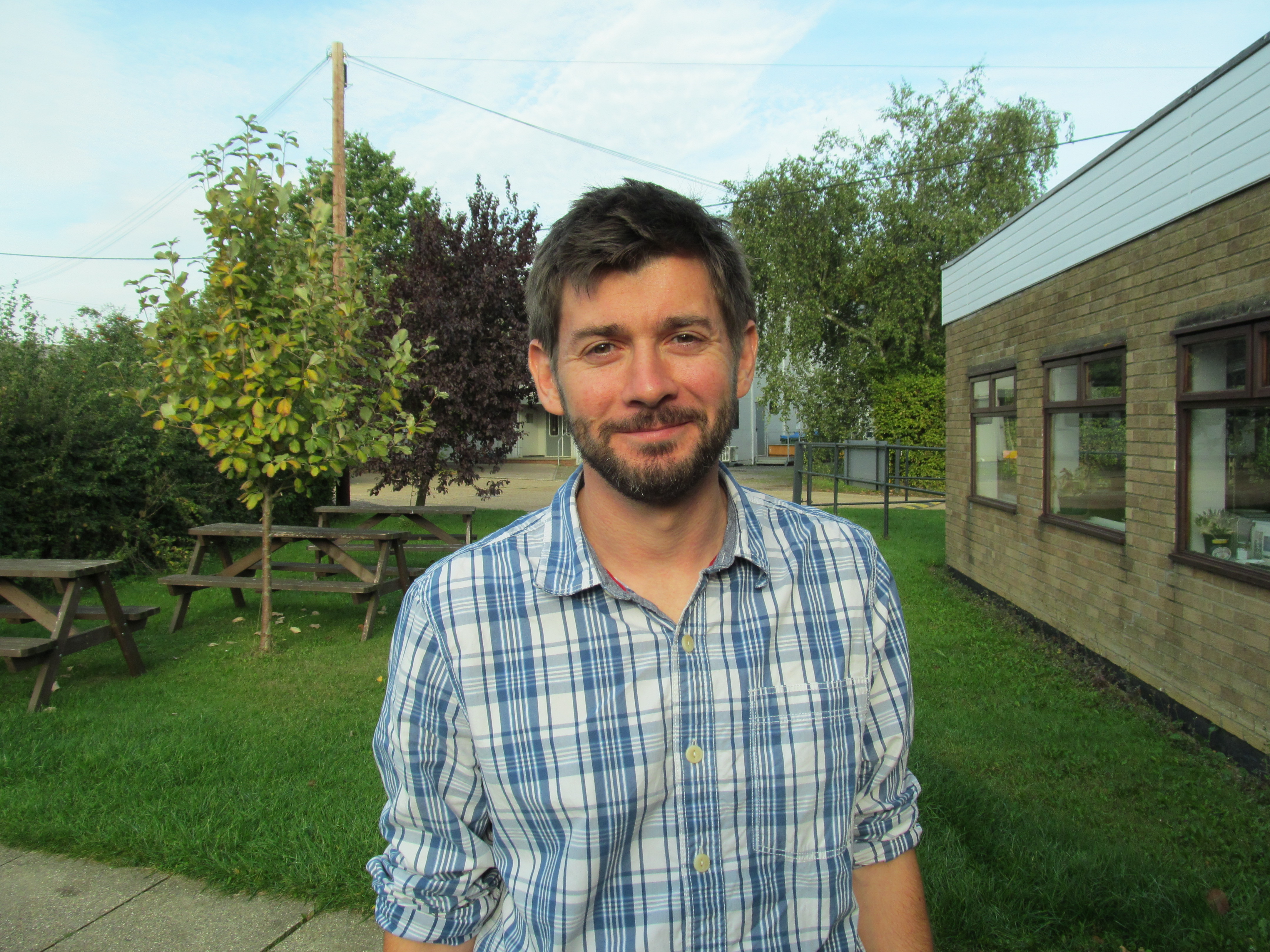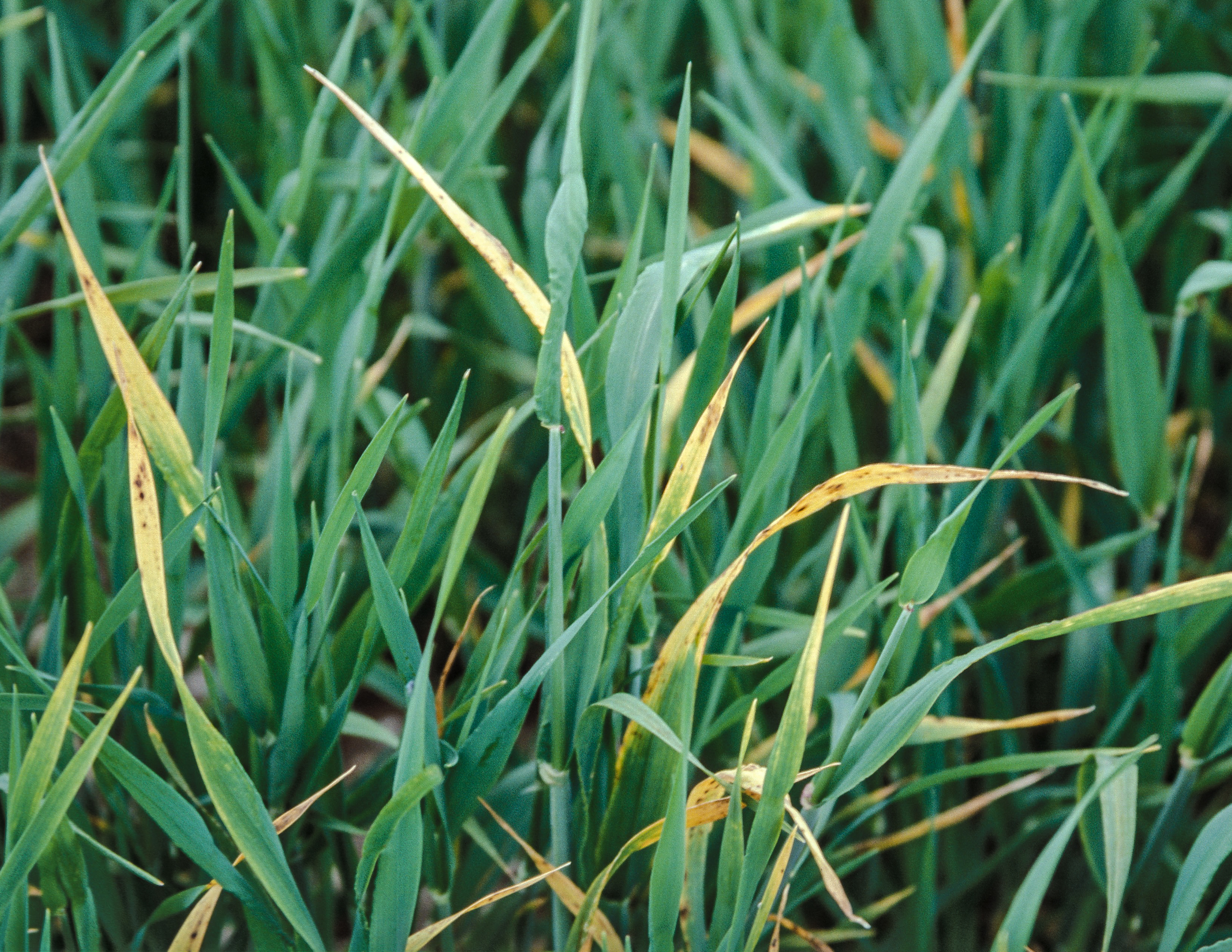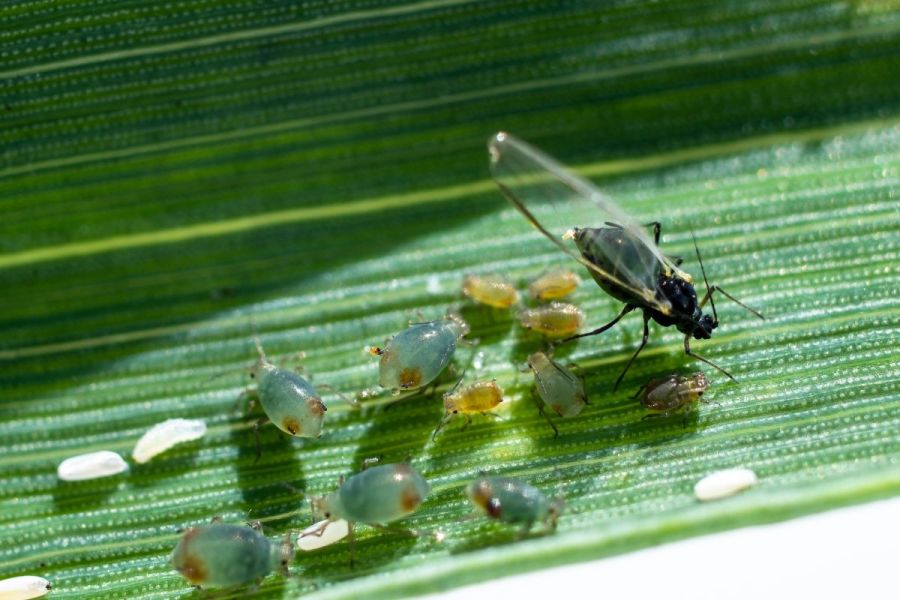Advice on barley yellow dwarf virus control has been crying out for an update. Outcomes of an ongoing AHDB-funded project looks set to help cereal growers manage the disease in a more economic and environmentally sensitive way. CPM reports.
If we use more of these sprays – which is almost guaranteed – then it increases the pressure for resistance.
By Adam Clarke
Growers are now reliant on one insecticide group to control aphids that transmit barley yellow BYDV in winter cereal crops. Inevitably, this will increase the risk of insensitivity building in vector populations, so the need to only apply sprays when absolutely necessary has never been more critical.
To help the industry achieve this goal, an ongoing AHDB-funded project, led by ADAS, is assessing aphid monitoring methods and designing a new decision support tool that could be available ahead of drilling in 2023.

So far results have shown that ACroBAT recommends less sprays and provides as much protection as the BYDV Tool, reports Sacha White
ADAS principal research entomologist Dr Sacha White is leading the project aiming to improve BYDV management, and he says advice on controlling BYDV in cereal crops has changed little in 30 years.
Setting out the background to the project, Sacha explains that there’s currently no economic treatment threshold for BYDV, so growers have often been urged to spray as soon as aphids are found in the crop. The advice was adapted slightly when neonicotinoid seed treatment Deter (clothianidin) was launched in cereals in around 2007. Its systemic activity allowed growers to establish crops and forget about pest control for 6-8 weeks, helping to manage their workload at a busy time and reduce the need for foliar sprays, he says.
Following the loss of clothianidin, growers are now solely reliant on pyrethroid sprays to control the two main BYDV vectors and this reliance will lead to worsening resistance to the group’s mode of action, says Sacha.
Some of the UK grain aphid population carry a heterozygous Kdr (knockdown resistance) genetic mutation that confers reduced sensitivity to pyrethroids. A well-timed spray containing full label rate should still provide adequate control in the field, but persistency may be affected, he explains.
For bird-cherry oat aphid, no insensitivity has been confirmed in the UK, so far, but there are early indications appearing in Ireland. In China, resistance to pyrethroids is established in its bird cherry-oat aphid population – evidence that it can and does happen, explains Sacha.
“If we use more of these sprays – which is almost guaranteed – then it increases the pressure for resistance. It means we might soon see increased resistance in the grain aphid and find resistance in the bird cherry-oat aphid so minimising insecticide use is important,” he says.
In response to clothianidin’s withdrawal, and to help optimise pyrethroid use, AHDB produced its BYDV Tool, available on its website, to help growers assess risk and target applications where necessary.
It allows growers to enter their location and crop emergence date, then counts accumulated day degrees above a baseline of 3⁰C from the day of crop emergence, known as a T-Sum calculation.
Once a T-Sum of 170 is reached, it’s assumed that the second and most damaging generation of aphid vectors has occurred and growers should check crops, confirm their presence, and consider an insecticide spray.
Following a spray, this calculation would start again where crops are still vulnerable. The migration of vectors typically finishes in early December, at which point BYDV risk wanes.
Once at GS31, crops are more developed, and any infection has little impact on yield.
While useful, there is a feeling that the BYDV Tool overestimates risk and results in unnecessary treatment, says Sacha. “For example, an early drilled crop may have five or more sprays recommended before GS31 is reached. This increases the risks to non-target organisms and resistance risk.”
Sacha says one of the two major objectives of the BYDV project is to develop a new tool that predicts the number of aphids in a given crop based on migration data, then use that information to calculate risk on a weekly basis.
Input metrics include field location, previous and current weather, crop information (eg wheat or barley), varietal tolerance, sowing date, planting density and virus infection levels in aphid populations (based on Rothamsted Research data).
He explains a cost-benefit analysis is then calculated to determine whether the predicted yield losses outweigh the cost of a spray. This economic element is important, says Sacha, as reducing sprays that will provide no benefit are key to minimising overall insecticide use.
Metrics for the economic threshold include current grain price, treatment costs and predicted yield. “We didn’t want to reinvent the wheel, so have produced a new system based on two models developed in the 1980s and 1990s. We’ve updated them, linked them together and designed them to be accessed via an app or webpage.
“The prototype is called the ADAS Crop BYDV Assessment Tool (or ACroBAT) and has been tested in small plot and tramline trials over the past two years and compared with untreated plots and those treated as per BYDV Tool advice,” says Sacha.
So far results have shown that ACroBAT recommends less sprays and provides as much protection as the BYDV Tool, he adds.
“This is good news, as it’s providing adequate control and helping to rationalise insecticide use, meaning less impact on the environment and a lower insecticide resistance risk.”
Asked when the new decision support tool might be available, Sacha suggested that was a question for AHDB, but it’s already usable and could be live ahead of the 2023-24 cropping season.
However, he would like to see further testing in a range of seasons before it’s offered to the masses. “If it’s available sooner rather than later, it would come with the caveat that it might not provide the protection needed, especially in a high-pressure year. Otherwise, we risk situations where the tool could indicate that risk is low but it’s high and they lose yield and, ultimately, confidence in the tool,” he says.
The second major objective of the project is to establish the most effective method of monitoring aphid migration, both on a landscape and local scale, to help inform spraying decisions.
The suction trap data collected by Rothamsted Research’s network of suction traps across Britain is extremely valuable at painting a picture of aphid migration on a regional scale.
However, grower feedback has revealed a lack of confidence in using the data to make management decisions on a local scale.
To try and put some hard data on its local value, Sacha’s team has been monitoring farms and fields at a range of distances and directions from five suction traps within the network.
The current investigation is still being analysed, so it is not possible to draw any conclusions.
However, Sacha says a 1990s study looking at the relationship between catches and numbers in crops between 1km and 40km away from the suction strap at Rothamsted in Hertfordshire offers some insight.
“The work found that the relationship was strong up to 40km from the trap. Based on that study, you’d say that if a field is within 40km, it provides a good indication of BYDV risk.
“However, we want to look at the relationship in a bit more detail and see if it’s the same around a range of traps, as they have a range of surrounding topography that might have a strong influence on results,” says Sacha.
The suction trap data is also being compared with the performance of yellow water traps and sticky traps, plus manually searching for aphids in crops.
In autumn 2021, Sacha’s team checked six crops twice. Each time, they inspected 100 plants and found a very low number of aphids – an average of one aphid for every 95 plants checked, which is a very low return for significant effort, he says.
Conversely, when setting up traps in fields, on average they found three aphids per trap.
“It seems that using in-field traps is a more effective way of monitoring aphids than crop inspection, giving a more accurate indication of BYDV risk,” says Sacha.
He adds that overall, the work showed yellow water traps catch about twice the number of aphids than sticky traps. But he also points out that if the farm or its advisor doesn’t have the skills to correctly identify what’s in the trap, training will be required to enable them to do so, or catches would need to be sent to labs like ADAS or Fera before results can be used.
“There’s a cost associated with that. One of the recommendations of the project when the final report comes out later this year will be which is the best, most cost-effective monitoring scheme for growers,” says Sacha.
The BYDV problem
BYDV can be devastating in winter cereal crops. Barley is particularly susceptible, with potential yield losses of up to 80%, while reductions of 2.1t/ha have been reported in wheat.

Winter barley is particularly susceptible to BYDV and can result in yield losses of up to 80% if the vectors aren’t controlled.
Two species of aphid are responsible for its spread in the UK – the grain aphid (Sitobion avenae) and the bird cherry-oat aphid (Rhopalosiphum padi).
The rose-grain aphid (Metopolophium dirhodum) is another vector, but it doesn’t overwinter well in cereals, so tends to move into crops during the spring where infection has much less impact on yield.
In the past, the assumption has been that if aphids are present, so is the virus. However, it has long been recognised that in practice, only a small proportion of aphids tend to carry BYDV and that this should be considered in assessing risk.
Quantifying the proportion infected in a rapid and affordable manner as been a problem in the past, but Rothamsted Research has recently developed a method to test aphids caught in the nationwide suction trap network for BYDV.
This has revealed that the majority don’t carry the virus and has important implications for the rate at which plants become infected in a crop.
The most damaging scenario is when any infected, winged individuals move into cereals crops at or soon after emergence (primary infection) and rapidly give rise to second and subsequent generations that spread away from the original colony (secondary infection).
Breeding and crop protection innovation key
Learning how varietal tolerance fits into control strategies and stewardship of insecticides are key drivers behind the involvement of plant breeder Limagrain and seeds and agrochemical supplier Syngenta in the AHDB-funded BYDV project.

Ron Granger believes genetics are the answer to reducing reliance on insecticides and will offer growers yield stability in high BYDV pressure seasons.
For Limagrain’s arable technical manager Ron Granger, genetics are the answer to reducing reliance on insecticides and will offer growers yield stability in high BYDV pressure seasons.
The company got involved with the project to see what value some current BYDV-tolerant winter barley varieties could provide as part of an integrated pest management strategy, and whether they still required treatment when aphid thresholds were met.
This included Limagrain’s Rafaela and fellow breeder KWS’s Amistar, which are both six-row conventional feed varieties that have come through continental breeding programmes and been imported to the UK.
The BYDV-tolerance trait has proven to be very effective in trials, yielding up to 50% more than non-tolerant winter barley varieties when exposed to high BYDV pressure.
In France, where the area of BYDV-tolerant varieties has increased significantly over the past five years to about 98%, growers are using little or no insecticide to protect against BYDV transmission, he says.
Commercial uptake in the UK is currently slow, says Ron, but new varieties with agronomic characteristics suited to UK conditions should soon emerge from breeding and increase the BYDV-tolerant area significantly.
Until widespread uptake is seen here, like in France, Ron believes it would be wrong not to manage aphids in tolerant varieties adjacent to non-tolerant crops if pressure was extremely high.
He says although tolerance is good and symptoms aren’t expressed, tolerant plants are still fighting hard against the virus and this potentially drags down yield, so is another argument for treatment.
Work as part of the ADAS-led project tested Rafaela and Amistar in both naturally infected and aphid inoculated plots, comparing an untreated control with those receiving one- and two-spray programmes to see if there was a benefit to treatment.
“The evidence suggests that if aphids reach a certain threshold, then it’s worth spraying – which is useful to know. It’s also important not to break the current genetics, as it’s a trait for securing yield in increasingly testing and erratic weather patterns.
“As we know from experience, nature finds a way around single gene resistances or tolerances more easily than multiple genes, so treating with an insecticide where pressure is high will help protect what we have.

The new decision support tool should help growers reduce insecticide use and maximise efficacy from those that are applied through better timing, says Max Newbert.
“Breeders are also looking for additional BYDV-tolerance genetics that could be implemented or stacked with the current genetics, which will help secure this valuable trait in the future,” says Ron.
Syngenta’s field technical manager Max Newbert hopes that the outcomes of the project will ensure the right spray choices are made, both economically and environmentally. This will help maintain yield, reduce the risk of exacerbating resistance in aphid vectors and extending the effective life of pyrethroid actives like lambda-cyhalothrin.
“We’re also very aware of the impact broad-spectrum contact insecticides can have and we want to minimise non-target interactions.
“If we can reduce sprays, while maximising efficacy of the ones that are applied through better timing, it’s effectively reducing input costs for growers, too. Getting [the ACroBAT tool] up and running will be a win-win for everyone,” says Max.
Research roundup
From Theory to Field is part of AHDB’s delivery of knowledge exchange on grower-funded research projects. CPM would like to thank AHDB for its support and in providing privileged access to staff and others involved in helping put these articles together.
For further info:
AHDB Project 21120077a: Management of aphid and BYDV risk in winter cereals is being led by RSK ADAS alongside scientific partner Rothamsted Research and industry partners BASF, KWS, Limagrain and Syngenta. Funding of £190,000 is provided by AHDB, with £124,500 provided by industry partners. The total project value is £314,500.
This article was taken from the latest issue of CPM. For more articles like this, subscribe here.




